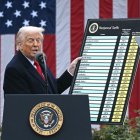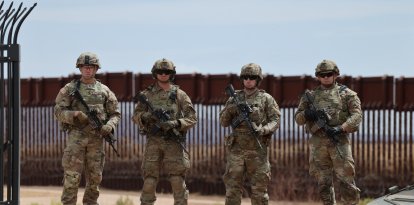Tariffs against the dragon: The strategy in the face of an inevitable conflict
If the United States were to go to war with China, or if Taiwan were to fall under Chinese control or siege, the risk of major battery and chip producers being left on the opposing side would be catastrophic for the global economy and the technological and military security of the West.

Xi Jinping and Donald Trump
Beijing's dominance of global trade has caused a schism between the world's two largest economies. At the center of this geopolitical storm are the strategic sectors of semiconductors and batteries, which not only reflect China's commercial supremacy, but also expose the fragility of a dependent global economy in the face of potential conflict.
Geopolitical forecasts and China's increasing military moves suggest that, within a couple of years, it could attack Taiwan, the world's largest chip producer. This event could place major battery and semiconductor producers on the opposite side of the U.S. and its allies, triggering an unprecedented technological crisis. It is in this context that Trump's tariffs must be interpreted: an attempt to weaken Chinese economic power, to curtail its progress of recent decades and to prepare for a potential war against a Chinese dictatorship that has distorted the rules of the free market.
Chinese dominance in batteries: A pillar of technological supremacy
The battery sector is a clear example of China's prowess in capturing industries and crushing foreign competitors that can no longer keep up. This is achieved through a combination of extensive government support and other non-tariff barriers. The key raw materials for battery production are found in places like Australia, Chile, Indonesia and the Democratic Republic of Congo, and China has a presence in all of them. Many of the world's cobalt, nickel and lithium mines are partially or majority owned by Chinese companies, including state-owned enterprises. Chinese groups have significant stakes in mines that account for about 70% of world production. In Indonesia, one of the world's largest nickel deposits is linked to Beijing, as are multiple mines in the country. Chinese companies also have investments in lithium projects in Argentina, Australia, Canada and Zimbabwe. Even where ownership of the mines remains in local hands, Chinese entities have secured long-term agreements for the supply of raw materials, as in Chile and Argentina.
Beijing's supremacy is even more evident further down the supply chain. China dominates mineral processing and component production, according to data from Benchmark Mineral Intelligence. The country is home to the vast majority of the refineries and factories that produce the key components that are then assembled into battery cells. China manufactures three out of every four lithium-ion batteries sold in the world, according to the International Energy Agency (IEA). Battery prices in the country have been falling at a faster rate than in the rest of the world, thanks to government foul play that has been crucial to consolidating the industry and reducing costs.
Batteries are just one prominent example among hundreds of products, such as computers, smartphones and steel, where China exerts absolute dominance in the global market. This economic and military advance by China has only been possible under the framework of a dictatorship that does not operate according to the rules of the free market. The Chinese Communist Party has used massive subsidies, state control of businesses, restrictions on foreign competition and exploitation of labor to build its export machine. This model, incompatible with the principles of transparency and fairness in international trade, has allowed China to accumulate competitive advantages for decades, distorting global markets and generating imbalances that Trump's tariffs now seek to correct.
"The struggle for control of trade and production of key technology is embedded in a world on the brink of conflict."
Taiwan and its 'silicon shield'
In the semiconductor realm, the situation is even more critical because of Taiwan's global dependence. Chips, which power everything from cell phones to electric cars, account for a huge percentage of Taiwan's GDP. The country produces more than 60% of the world's semiconductors and more than 90% of the most advanced ones, most of them manufactured by a single company: Taiwan Semiconductor Manufacturing Company (TSMC). Until now, the most advanced chips have been manufactured almost exclusively in Taiwan. The semiconductor industry is known as Taiwan's "silicon shield," giving the world a great reason to defend the island. However, chips are the industry most affected by the U.S.-China divide, and a Chinese attack on Taiwan could cripple the global supply of this essential technology.
Taiwan Semiconductor Manufacturing Company is the world's largest contract manufacturer of chips, used in everything from Apple's iPhones to Nvidia's cutting-edge artificial intelligence hardware. TSMC reported that its revenue in the first three months of 2025 rose nearly 42%, beating all expectations.
Taiwan had sought to avoid Trump's tariffs by promising greater investment in the U.S., more purchases of American energy and increased defense spending. TSMC announced that it would invest $100 billion in the United States, a move that Taiwan's President Lai Ching-te called a "historic moment" for Taiwan-U.S. relations.
This announced investment came after Trump's accusations that Taiwan stole the U.S. chip industry and his threats to impose tariffs of up to 100%. Trump eventually slapped 32% on Taiwanese imports, but yesterday abruptly halted their implementation for almost all countries except China for 90 days.
TSMC has long faced demands to move more of its production out of Taiwan amid fears that critical technology supplies could be disrupted in a conflict with Beijing. China has increased military pressure on Taiwan in recent years to push its claim to sovereignty over the autonomous island, where TSMC has its headquarters and most of its manufacturing plants.
China's escalating war: An imminent threat
China has invested multibillion-dollar figures in chip manufacturing, hoping to meet 70% of domestic chip demand by 2025. It has also poached engineers, executives and trade secrets from Taiwan. This brain drain has alarmed the Taiwanese government, which has passed new laws against economic espionage. The United States is also trying to prevent China from acquiring advanced chips. Yet this is the reality of a world reshaping itself around geopolitical risk. If China attacks Taiwan, control of semiconductors could further consolidate its economic dominance.
In this context, on Feb. 26, China accused Taiwanese authorities of handing over tjhe country's semiconductor industry to the United States as a "souvenir" and called the stance of the ruling Democratic Progressive Party (PDP) "shameless," which it blamed for using the technology sector as a "bargaining chip" to gain international support.
But Taiwan's move is justified as China has stepped up its military drills around the island. In recent months, China has stepped up its live-fire warfare actions, focusing on Taiwan and the Indo-Pacific. In April 2025, Strait-Thunder 2025A exercises included 19 ships, 76 flights and full blockade simulations of Taiwan. In February, maneuvers near Kaohsiung and Pingtung involving 32 aircraft and 13 ships simulated unannounced attacks. In January, in exercises in the Gulf of Tonkin, they practiced maritime assaults against Vietnam, while in December, gunfire in the Tasman Sea projected naval power towards Australia and New Zealand. These actions, almost daily and normalized, show an escalation in frequency and sophistication, with multi-domain coordination and objectives of pressure on Taiwan and preparation for conflict.
These maneuvers reflect a significant increase in Chinese military pressure, which seeks to demonstrate its ability to isolate Taiwan and deter any external support, especially from the United States.

World
Hegseth announces an agreement with Panama to guarantee free and priority passage of warships through the canal
Luis Francisco Orozco
The danger of war with China and having key producers on the opposite side
China's trade surplus reached nearly $1 trillion last year. This Beijing export machine is one of the main reasons why President Donald Trump has fired the first shots in his new global trade war. No country has escaped Trump's tariffs, but China is the main target.
Trump hopes his tariff regime will erode China's surplus; however, Beijing relies on deep advantages forged over decades that will not be easily dismantled. If the U.S. were to go to war with China, or if Taiwan were to fall under Chinese control or siege, the risk of major battery and chip producers being left on the opposing side would be catastrophic for the global economy and the West's technological and military security. The dependence of the U.S. and its allies on Taiwanese semiconductors and Chinese batteries is overwhelming. A conflict could cripple key industries such as defense. In addition, China could restrict access to essential components, leaving the U.S. and its allies at an extreme strategic disadvantage.
The trade war and military escalation cannot be understood separately. The struggle for control of trade and production of key technology is embedded in a world on the brink of conflict. Trump's tariffs seek not only to slow China's economic advance, an advance rigged by a colonialist dictatorship, but also to prepare the West for a war that could redraw the global order.


























